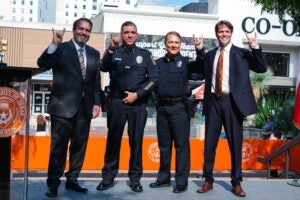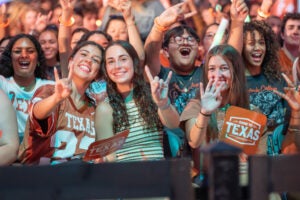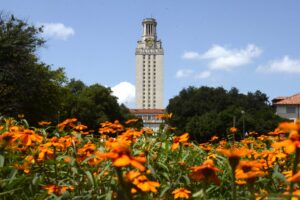A team of mechanical engineering professors at The University of Texas at Austin has received $1.9 million to expand a computer model that is already helping guide national decisions about placement of devices to detect nuclear smuggling attempts.

|
| Mechanical engineering professors consider a European map used to visualize potential routes of nuclear smugglers. With the grant from the Domestic Nuclear Detection Office of the Department of Homeland Security, Dr. David Morton (left), Dr. Erich Schneider (center) and Dr. Elmira Popova (right) will spend five years expanding the computer model for radiation detector placements based on detailed information about smuggling scenarios and models of smugglers’ strategic behavior. Schneider will build the computer model’s description of the nuclear material being smuggled and radiation detectors’ recognition of concealed material. Popova will provide probability calculations and run computer simulations to test the computer model. |
| Photo: Erin McCarley |
The U.S. Department of Homeland Security provided the funds to improve the design of networks of sensors to detect smuggling in Russia and other countries of the former Soviet Union that have insufficient security for their stores of nuclear weapons material and radioactive material. Nearly 300 nuclear smuggling attempts have been reported to the United Nations from these countries since 1995.
In the past four years, Los Alamos National Laboratory has used the basic nuclear smuggling model developed by Dr. David Morton and former graduate student Feng Pan to help combat this trend by providing guidance for national decisions on radiation detector placement in Russia and nearby countries. Morton and Dr. Erich Schneider and Dr. Elmira Popova will now spend five years improving the model.
“Russia’s got the biggest border of any country on the planet, making it highly unlikely the country could seal its borders,” said Morton. “So the real issue becomes: given the limited resources and the fact that radiation detectors can cost upwards of $1 million to set up, can we provide a computer tool that locates the detectors optimally?”
The United States has provided more than $100 million to place radiation detectors at Moscow’s main airport and other sites where smugglers could escape with material for preparing nuclear weapons or dirty bombs. Still, hundreds more potential nuclear smuggling sites in Russia and around the world could use radiation detectors. The computer model seeks to prioritize decisions on sites to outfit based on:
- routes smugglers typically take to reach buyers willing to pay millions for their stash,
- nuclear and radioactive materials most likely to be smuggled and
- methods smugglers will use to conceal their dangerous cargo.
The computer model in use at Los Alamos considers smugglers’ passage through pedestrian, automobile, rail, airport and sea crossings. Los Alamos also uses Morton’s nuclear smuggling model for detective work when a smuggler is captured. The goal is to go beyond speculation about the source of the material and other details.
“It’s common for a smuggler to transport really small amounts of nuclear material,” said Morton, who holds an Engineering Foundation Endowed Professorship. “The danger is that this nuclear material actually represents a larger mass at risk of being stolen if a buyer likes the original sample provided.”
With the $1.9 million from the Domestic Nuclear Detection Office of the Department of Homeland Security, the mechanical engineering faculty will spend five years expanding the computer model for placing radiation detectors with detailed information about smuggling scenarios and models of smugglers’ strategic behavior. Assistant Professor Schneider will build the computer model’s description of the nuclear material being smuggled and of how the radiation detectors recognize concealed material. Associate Professor Popova will provide probability calculations for the computer model, and run computer simulations to test it.
In other work, Morton is applying $270,000 from the National Science Foundation to develop a related computer model approach to guide various decisions at other organizations. For example, he and Popova are helping the South Texas Project prioritize capital-improvement projects at the nuclear power plant in Bay City, Texas.
Morton is also working with Integrative Biology and Philosophy Professor Sahotra Sarkar at The University of Texas at Austin to test a computer model for decisions about creating conservation area networks to protect wildlife. For example, the modeling helps decide specific areas to protect in the Balcones Canyonlands. The additions expand existing wildlife refuges and preserves in the Austin area to protect endangered birds.
“From nuclear smugglers to Golden-cheeked Warblers, these computer models have all sorts of applications to making important decisions in the face of significant uncertainties,” Morton said.



